| Diese Seite auf Deutsch! |
Snails and Slugs (Gastropoda)Gastropoda Cuvier, 1795 |
 Amber snails (Succinea ) of all terrestrial snails live nearest to water. Picture: Robert Nordsieck. |
Yet the world of snails harbours many fascinating secrets still waiting to be discovered!
There are over 70,000 species of snails, ranging in size from less than a millimetre to 75 centimetres. Snails are not only found on land, but also in marine and freshwater habitats. Among them are the vividly coloured sea slugs and the cowries, whose shells were used as a currency for centuries across Africa, Asia, Oceania, and the Americas.
![]() Cowry shells as a
currency.
Cowry shells as a
currency.![]() Sea shells: Systematiics and
diversity.
Sea shells: Systematiics and
diversity.
 |
|
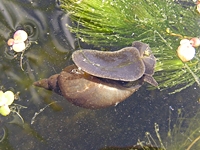 |
|
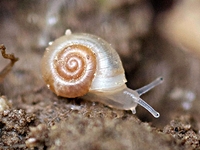 |
Some snails can even walk on water – or rather, glide along its surface, as seen in certain freshwater species such as the pond snails (Lymnaeidae) and ramshorn snails (Planorbidae).
![]() Pond snails (Lymnaeidae)
Pond snails (Lymnaeidae)
![]() Ramshorn snails (Planorbidae)
Ramshorn snails (Planorbidae)
There are venomous sea snails in the sea, such as cone snails (Conidae), that hunt their prey, even fish, using harpoon-like teeth. Others, like whelks (Buccinidae), ambush unsuspecting bivalves. Even on land, some predatory snails track their prey by scent, pursuing them across streams and even up trees until the hunt is successful — such as the tropical rosy wolf snail.
![]() Rosy wolf snail (Euglandina rosea).
Rosy wolf snail (Euglandina rosea).
![]() Cone shells (Conidae)
Cone shells (Conidae)
![]() Whelks (Buccinidae)
Whelks (Buccinidae)
In southern Europe, the Dalmatian predator snail (Poiretia cornea) hunts terrestrial operculate snails such as Pomatias elegans. It etches a hole in the shell wall of its prey and consumes the defenceless snail through the opening. Other native European predatory snails hunt earthworms: "rucksack snails" (Testacellidae and Daudebardiidae) sometimes devour worms longer than themselves, so the worm is being eaten and digested at the same time: headfirst and tail out.
![]() Terrestrial operculate snails (Pomatiiidae).
Terrestrial operculate snails (Pomatiiidae).
![]() Dalmatian predator snail (Poiretia
cornea).
Dalmatian predator snail (Poiretia
cornea).![]() Rucksack snails (Testacellidae
and Daudebardiidae).
Rucksack snails (Testacellidae
and Daudebardiidae).
Some sea slugs feed on jellyfish and store their stinging cells to use in their own defence. Sea angels, ethereal, transparent snails, drift through the open ocean, feeding on sea butterflies, other snails that capture plankton with mucous nets. In turn, they themselves are eaten by fish and whales, making them an important part of the marine food chain. One marine predatory snail even feeds on other snails — without having a single tooth in its mouth.
![]() Nudibranchs (Nudibranchia).
Nudibranchs (Nudibranchia).
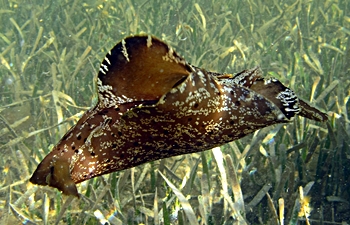 Sea hare swimming (Aplysia morio). The animal is swimming towards the left. Picture: Sean Nash (Source). |
Gastropods have been used to research the neurobiology of learning - especially sea hares (Aplysiomorpha), which became known for the large neurons suitable for research.
![]() Sea hares (Aplysia) in
neurobiology.
Sea hares (Aplysia) in
neurobiology.
The scientific study of snails – a branch of zoology known as malacology, or more specifically conchology (the study of shells) – is important in many areas of biology. Snail species are considered valuable bioindicators in biodiversity research, since they respond sensitively to environmental changes. Events such as the "GEO Day of Biodiversity" highlight the vital role molluscs play in monitoring and documenting species diversity.
In addition to biodiversity, researchers also study the relationships and evolutionary history of different snail groups. The fields of taxonomy and systematics seek to arrange the known groups of gastropods into a coherent classification system that reflects their evolutionary relationships and ancestry. In many cases, modern genetic methods are needed, as closely related species are often very difficult to distinguish by appearance alone.
![]() GEO Day of Biodiversity
in the Vienna Woods Biosphere Reserve.
GEO Day of Biodiversity
in the Vienna Woods Biosphere Reserve.
![]() Snails in Science (coming
soon).
Snails in Science (coming
soon).
 "Lusitanian" slug (Arion vulgaris). Picture: Robert Nordsieck. |
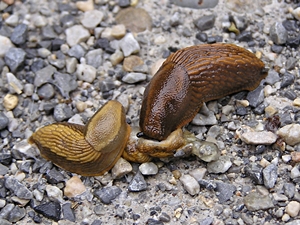 Two juvenile "Lusitanian" slugs (Arion vulgaris) feeding on a smaller one of their kind. Picture: Robert Nordsieck. |
![]() Snails and Slugs in the Garden.
Snails and Slugs in the Garden.
Still, there are indeed some species of snails that can become problematic. In some cases, this is due to the absence of natural predators – in gardens, for example, these include threatened species such as the common toad or the hedgehog. In other cases, it is due to environmental changes: the so-called Spanish slug (Arion vulgaris), which would normally die after laying its eggs in winter, can now survive the milder winters brought about by climate change, and often appears in particularly large numbers in spring.
![]() Roundback slugs
(Arionidae).
Roundback slugs
(Arionidae).
Other species, such as the Giant African Snail (Lissachatina fulica) or the Rosy Wolfsnail (Euglandina rosea), can spread rapidly and cause serious damage when introduced by humans to regions without natural enemies. Lissachatina fulica is considered a major agricultural pest, while Euglandina rosea, on the other hand, has been responsible for the decline of native snail species in several parts of the world.
The aforementioned Spanish slug (Arion vulgaris) is also often spread unintentionally by humans, for instance through garden soil. Similarly, the Brown Garden Snail (Cornu aspersum), which has expanded significantly in some regions of Lower Austria from the area around Vienna, has largely been introduced or distributed by human activity, even hanging in cars, and is now increasing rapidly in numbers.
![]() Giant African Snails
(Achatinidae).
Giant African Snails
(Achatinidae).![]() Rosy Wolf Snail
(Euglandina rosea).
Rosy Wolf Snail
(Euglandina rosea).
![]() Brown Garden Snail (Cornu aspersum).
Brown Garden Snail (Cornu aspersum).
Many snail species are hermaphrodites – meaning that each individual possesses both male and female reproductive organs. This allows for unique mating rituals, such as the use of so-called "love darts" in helicid snails. On the other hand, a great number of freshwater snails are dioecious, meaning they have separate sexes.
![]() The Love Dart in Snail
Reproduction.
The Love Dart in Snail
Reproduction.
Some snails are able to survive periods of extreme drought by retreating into their shells and sealing the aperture with a calcareous lid (epiphragm). Others inhabit caves, live on volcanoes, or even in the deep sea – clear evidence of their remarkable adaptability.
![]() Aestivation
and
Hibernation in Roman Snails (Helix
pomatia).
Aestivation
and
Hibernation in Roman Snails (Helix
pomatia).
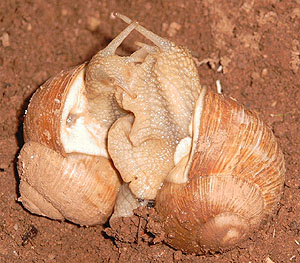 A rare picture: A sinistral snail king (on the right) mating with a dextral (normally coiled right handed) Roman Snail. Picture: Peter Leonhardt (Felix-Helix-Projekt). |
Most snail species exhibit either right-handed (dextral) or left-handed (sinistral) shell coiling, which is species-specific. However, there are notable exceptions, such as the very rare "snail kings" of the Roman snail (Helix pomatia), which coil in the opposite direction of the usual pattern.
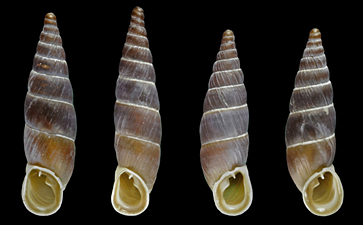 Sinistral door snail (Alopia straminicollis) and dextral door snail (Alopia li- vida) from the Velikan valley (Bucegi Mts., Romania). Picture: Sigrid Hof (Source: hnords.de). |
Not nearly all snails possess a shell: In many groups, both terrestrial and aquatic, the shell has been reduced or lost entirely over the course of evolution, often for reasons of improved mobility. In Europe, the varying degrees of shell reduction can be particularly well observed in glass snails and their relatives (Vitrinidae and related families).
![]() Glass Snails (Vitrinidae).
Glass Snails (Vitrinidae).
![]() Vitrinisation: The Gradual Evolution of Slugs.
Vitrinisation: The Gradual Evolution of Slugs.
Unfortunately, many species of snails are endangered – threatened by habitat destruction, pesticides, invasive species, climate change, and not least by various forms of human exploitation. Some, like the Partula snails, have already gone extinct in the wild and survive only in dedicated conservation projects.
![]() Partula Snails (Partulidae).
Partula Snails (Partulidae).
 Wentle trap snail (Epitonium scalare), Western Australia. Picture: Glen Whisson (iNaturalist). |
 Hermann Löns observing a slug. |
The mollusc collection of the Natural History Museum Vienna still features a wentletrap on its homepage today.
![]() Vienna Natural History Museum:
The Old Naturalia Collection 1748-1796.
Vienna Natural History Museum:
The Old Naturalia Collection 1748-1796.
![]() Vienna Natural History Museum:
The Natural History Museum's Mollusc Collection.
Vienna Natural History Museum:
The Natural History Museum's Mollusc Collection.
Snails have also left their mark on literature. Author Patricia Highsmith was a self-confessed snail enthusiast and is said to have attended social gatherings with live snails in her handbag. Her writing contains frequent allusions to molluscs – even eerie short stories which snails play a central role in.
In contrast, the book "The Sound of a Wild Snail Eating" by Elizabeth Tova Bailey offers a gentle, poetic reflection on the quiet companionship of a snail during the narrator’s long illness.
The famous German "Poet of the Heath", Hermann Löns (1866 - 1914), was also a respected malacologist: He published a number of scientific articles on snails and slugs, as well as humorous stories in which they featured, such as "Ein ekliges Tier" ("An Icky Creature").
In Michael Ende’s timeless novel The Neverending Story, the gnome Ückück rides a racing snail. And indeed, some aquatic bladder snails (Physidae) are remarkably fast for their kind. Even in the unlikely setting of the video game World of Warcraft, snails frequently make an appearance – as pets, wild creatures, or even mounts.
![]() How fast are snails? A comparison.
How fast are snails? A comparison.
![]() Snails in Culture
(coming soon)
Snails in Culture
(coming soon)
The aim of this website is to introduce you to this fascinating group of animals and to spark your curiosity about a world that often hides in plain sight.
 "The Living World of Molluscs" on http://www.molluscs.at by Robert Nordsieck for 25 years: 2000 - 2025! |
![]() Weichtiere.at YouTube Channel with several videos to watch (so far only in German)!
Weichtiere.at YouTube Channel with several videos to watch (so far only in German)!



New: The page about
Leopard slugs (Limax maximus) has been completely revised and many pictures by
Martina Eleveld,
especially about
leopard slugs mating, have been added, note there additionally is a
Video Playlist on the same topic on our YouTube channel!

Picture:
Haus der Natur in Cismar.
Identification charts "Molluscs of Austria - Snails with a Shell" and
"Molluscs of Austria - Fresh Water Snails and Slugs"
![]() Additional Information!
(In German).
Additional Information!
(In German).
Available in the
Vienna Natural History
Museum and in the Haus
der Natur in Cismar, Germany.
Overview over German and Dutch identification charts:
http://www.miniposter.hausdernatur.de/.


http://www.mollusca.de:
Homepage of the
German Malacozoological Society all about mollusc research.

Molluskenforschung Austria
Austria-wide Platform
for Mollusc Researchers.

Naturkundemuseum Stuttgart: Molluscs -
Identification, Systematics, Finding Reports.

Molluscs at Naturschutzbund Deutschland (NABU)
(German Nature Conservation Society)
Latest Change: 03.10.2025 (Robert Nordsieck).